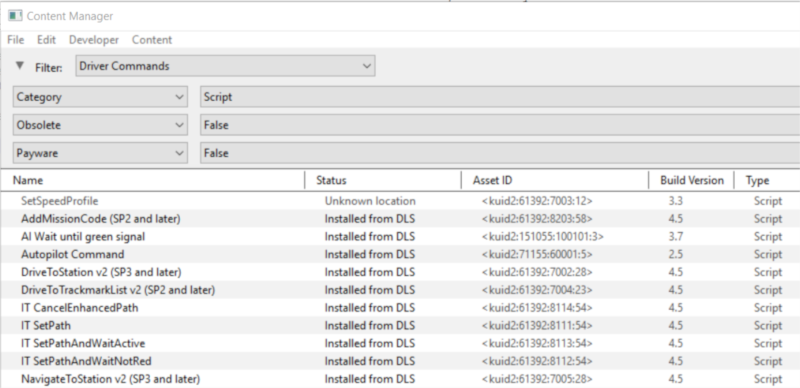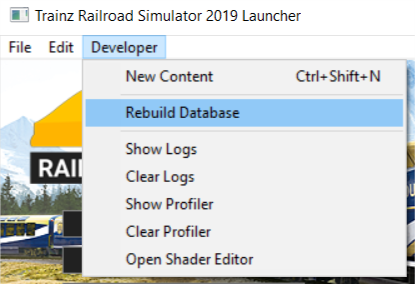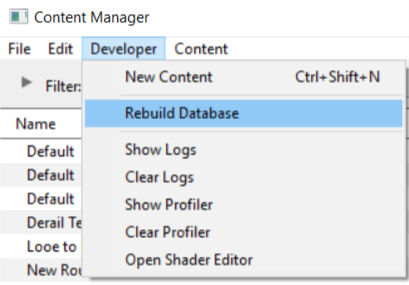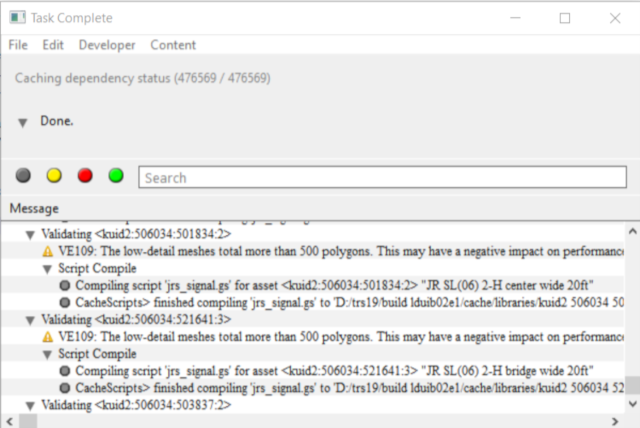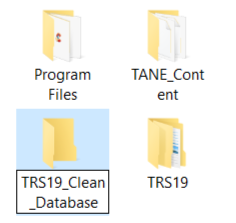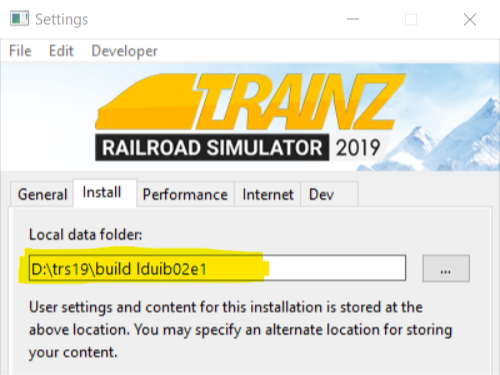How to Perform Database Repairs
m (Replaced <font> tags with <span> tags and CSS) |
m (removed hyperlinks from all images) |
||
| Line 8: | Line 8: | ||
<table cellpadding="4" bgcolor=#c1e7e7> | <table cellpadding="4" bgcolor=#c1e7e7> | ||
<tr valign="top"> | <tr valign="top"> | ||
| − | <td>[[file:DotPoint.JPG]]</td> | + | <td>[[file:DotPoint.JPG|link=]]</td> |
<td>The '''Trainz Database''' contains all the installed assets</td> | <td>The '''Trainz Database''' contains all the installed assets</td> | ||
</tr> | </tr> | ||
| Line 22: | Line 22: | ||
<tr> | <tr> | ||
<td> | <td> | ||
| − | [[file:DBR_EDBR20.png]] | + | [[file:DBR_EDBR20.png|link=]] |
</td> | </td> | ||
</tr> | </tr> | ||
| Line 34: | Line 34: | ||
<table cellpadding="4" bgcolor=#c1e7e7> | <table cellpadding="4" bgcolor=#c1e7e7> | ||
<tr valign="top"> | <tr valign="top"> | ||
| − | <td>[[file:DotPoint.JPG]]</td> | + | <td>[[file:DotPoint.JPG|link=]]</td> |
<td>A '''DBR''' performs a "surface scan" of the database detecting missing content and content errors. It will update your database and can clean up some corrupted data.</td> | <td>A '''DBR''' performs a "surface scan" of the database detecting missing content and content errors. It will update your database and can clean up some corrupted data.</td> | ||
</tr> | </tr> | ||
| Line 43: | Line 43: | ||
<table cellpadding="4" bgcolor=#ffffb0> | <table cellpadding="4" bgcolor=#ffffb0> | ||
<tr valign="top"> | <tr valign="top"> | ||
| − | <td>[[file:NotePad.PNG]]</td> | + | <td>[[file:NotePad.PNG|link=]]</td> |
<td><span style="font-size: 17px;">'''Notes:'''</span><br> | <td><span style="font-size: 17px;">'''Notes:'''</span><br> | ||
Perform a '''DBR''' if you have:- | Perform a '''DBR''' if you have:- | ||
| Line 55: | Line 55: | ||
<table cellpadding="4" bgcolor=#ffffb0> | <table cellpadding="4" bgcolor=#ffffb0> | ||
<tr valign="top"> | <tr valign="top"> | ||
| − | <td>[[file:PencilTips.PNG]]</td> | + | <td>[[file:PencilTips.PNG|link=]]</td> |
<td>If you have installed a new asset that CM reports has having "missing" or "unknown" assets then a DBR is '''very unlikely''' to find those missing assets.</td> | <td>If you have installed a new asset that CM reports has having "missing" or "unknown" assets then a DBR is '''very unlikely''' to find those missing assets.</td> | ||
</tr> | </tr> | ||
| Line 66: | Line 66: | ||
</tr> | </tr> | ||
<tr valign="top"> | <tr valign="top"> | ||
| − | <td>[[file:Steps.PNG]]</td> | + | <td>[[file:Steps.PNG|link=]]</td> |
<td><span style="font-size: 17px;">'''Steps (both TRS19 and TANE):'''</span><br> | <td><span style="font-size: 17px;">'''Steps (both TRS19 and TANE):'''</span><br> | ||
<table cellpadding="4" bgcolor=#ffffff> | <table cellpadding="4" bgcolor=#ffffff> | ||
<tr valign="top"> | <tr valign="top"> | ||
| − | <td>[[file:DBR_EDBR01.png]]</td> | + | <td>[[file:DBR_EDBR01.png|link=]]</td> |
| − | <td>[[file:DBR_EDBR02.png]]</td> | + | <td>[[file:DBR_EDBR02.png|link=]]</td> |
</tr> | </tr> | ||
<tr valign="top"> | <tr valign="top"> | ||
| Line 87: | Line 87: | ||
The process will proceed automatically and unaided through a number of steps, '''only some of which are shown below'''. The time required for each step will vary enormously (some will take much longer than others) and the total time involved will depend on the number of assets installed, the speed of your system and other factors.<br><br> | The process will proceed automatically and unaided through a number of steps, '''only some of which are shown below'''. The time required for each step will vary enormously (some will take much longer than others) and the total time involved will depend on the number of assets installed, the speed of your system and other factors.<br><br> | ||
1. '''Scanning for deleted asset files'''<br> | 1. '''Scanning for deleted asset files'''<br> | ||
| − | [[file:DBR_EDBR03.png]]<br><br> | + | [[file:DBR_EDBR03.png|link=]]<br><br> |
2. '''Scanning for added asset files'''<br> | 2. '''Scanning for added asset files'''<br> | ||
| − | [[file:DBR_EDBR04.png]]<br><br> | + | [[file:DBR_EDBR04.png|link=]]<br><br> |
3. '''Importing built in assets'''<br> | 3. '''Importing built in assets'''<br> | ||
| − | [[file:DBR_EDBR06.png]]<br><br> | + | [[file:DBR_EDBR06.png|link=]]<br><br> |
4. '''Rebuilding cached asset data'''<br> | 4. '''Rebuilding cached asset data'''<br> | ||
| − | [[file:DBR_EDBR07.png]]<br><br> | + | [[file:DBR_EDBR07.png|link=]]<br><br> |
The '''Rebuilding Trainz Asset Database''' window will disappear if the DBR process has been successfully completed without finding any errors. If errors have been found then the window will remain on the screen to report on the number of errors and warnings.<br> | The '''Rebuilding Trainz Asset Database''' window will disappear if the DBR process has been successfully completed without finding any errors. If errors have been found then the window will remain on the screen to report on the number of errors and warnings.<br> | ||
<br> | <br> | ||
| Line 101: | Line 101: | ||
<table cellpadding="4" bgcolor=#c1e7e7> | <table cellpadding="4" bgcolor=#c1e7e7> | ||
<tr valign="top"> | <tr valign="top"> | ||
| − | <td>[[file:DotPoint.JPG]]</td> | + | <td>[[file:DotPoint.JPG|link=]]</td> |
<td>An '''EDBR''' performs a "deep scan" of the database and checks that the data in every asset conforms to the rules for that type of asset</td> | <td>An '''EDBR''' performs a "deep scan" of the database and checks that the data in every asset conforms to the rules for that type of asset</td> | ||
</tr> | </tr> | ||
| Line 109: | Line 109: | ||
<table cellpadding="4" bgcolor=#ffffb0> | <table cellpadding="4" bgcolor=#ffffb0> | ||
<tr valign="top"> | <tr valign="top"> | ||
| − | <td>[[file:NotePad.PNG]]</td> | + | <td>[[file:NotePad.PNG|link=]]</td> |
<td><span style="font-size: 17px;">'''Notes:'''</span><br> | <td><span style="font-size: 17px;">'''Notes:'''</span><br> | ||
*This is a more complex, slower and potentially more troublesome repair process | *This is a more complex, slower and potentially more troublesome repair process | ||
| Line 120: | Line 120: | ||
<table cellpadding="4" bgcolor=#fcbcbc> | <table cellpadding="4" bgcolor=#fcbcbc> | ||
<tr valign="top"> | <tr valign="top"> | ||
| − | <td>[[file:Stop.PNG]]</td> | + | <td>[[file:Stop.PNG|link=]]</td> |
<td>It is not unusual for CM to display a list of faulty assets '''after an EDBR''' that were not shown as faulty before the EDBR was run</td> | <td>It is not unusual for CM to display a list of faulty assets '''after an EDBR''' that were not shown as faulty before the EDBR was run</td> | ||
</tr> | </tr> | ||
| Line 131: | Line 131: | ||
</tr> | </tr> | ||
<tr valign="top"> | <tr valign="top"> | ||
| − | <td>[[file:Steps.PNG]]</td> | + | <td>[[file:Steps.PNG|link=]]</td> |
<td><span style="font-size: 17px;">'''Steps (both TRS19 and TANE):'''</span><br> | <td><span style="font-size: 17px;">'''Steps (both TRS19 and TANE):'''</span><br> | ||
<table cellpadding="4" bgcolor=#ffffff> | <table cellpadding="4" bgcolor=#ffffff> | ||
<tr valign="top"> | <tr valign="top"> | ||
| − | <td>[[file:DBR_EDBR01.png]]</td> | + | <td>[[file:DBR_EDBR01.png|link=]]</td> |
| − | <td>[[file:DBR_EDBR02.png]]</td> | + | <td>[[file:DBR_EDBR02.png|link=]]</td> |
</tr> | </tr> | ||
<tr valign="top"> | <tr valign="top"> | ||
| Line 156: | Line 156: | ||
<tr> | <tr> | ||
<td> | <td> | ||
| − | [[file:DBR_EDBR10.png]] | + | [[file:DBR_EDBR10.png|link=]] |
</td> | </td> | ||
</tr> | </tr> | ||
| Line 166: | Line 166: | ||
<table cellpadding="4" bgcolor=#c1e7e7> | <table cellpadding="4" bgcolor=#c1e7e7> | ||
<tr valign="top"> | <tr valign="top"> | ||
| − | <td>[[file:DotPoint.JPG]]</td> | + | <td>[[file:DotPoint.JPG|link=]]</td> |
<td>Creating a '''Clean Database''':- | <td>Creating a '''Clean Database''':- | ||
*will return your TRS19 or TANE database to its original, newly installed, condition | *will return your TRS19 or TANE database to its original, newly installed, condition | ||
| Line 176: | Line 176: | ||
<table cellpadding="4" bgcolor=#ffffb0> | <table cellpadding="4" bgcolor=#ffffb0> | ||
<tr valign="top"> | <tr valign="top"> | ||
| − | <td>[[file:NotePad.PNG]]</td> | + | <td>[[file:NotePad.PNG|link=]]</td> |
<td><span style="font-size: 17px;">'''Notes:'''</span><br> | <td><span style="font-size: 17px;">'''Notes:'''</span><br> | ||
This process will create a new Trainz database containing only the '''built in''' and '''base''' assets that came with the original Trainz (TRS19 or TANE) installation (a "clean" database). Use this option if you want to remove from your Trainz install all:- | This process will create a new Trainz database containing only the '''built in''' and '''base''' assets that came with the original Trainz (TRS19 or TANE) installation (a "clean" database). Use this option if you want to remove from your Trainz install all:- | ||
| Line 188: | Line 188: | ||
<table cellpadding="4" bgcolor=#fcbcbc> | <table cellpadding="4" bgcolor=#fcbcbc> | ||
<tr valign="top"> | <tr valign="top"> | ||
| − | <td>[[file:Stop.PNG]]</td> | + | <td>[[file:Stop.PNG|link=]]</td> |
<td>You will be creating another copy of the database but without any downloaded content. You will need enough space on your selected data drive to hold the data. Your original database will not be affected and will remain in its current location until you choose to delete, move or restore it.</td> | <td>You will be creating another copy of the database but without any downloaded content. You will need enough space on your selected data drive to hold the data. Your original database will not be affected and will remain in its current location until you choose to delete, move or restore it.</td> | ||
</tr> | </tr> | ||
| Line 199: | Line 199: | ||
</tr> | </tr> | ||
<tr valign="top"> | <tr valign="top"> | ||
| − | <td>[[file:Steps.PNG]]</td> | + | <td>[[file:Steps.PNG|link=]]</td> |
<td><span style="font-size: 17px;">'''Step 1: Create a Container'''</span><br> | <td><span style="font-size: 17px;">'''Step 1: Create a Container'''</span><br> | ||
<table cellpadding="4" bgcolor=#ffffff> | <table cellpadding="4" bgcolor=#ffffff> | ||
<tr valign="top"> | <tr valign="top"> | ||
| − | <td>[[file:DBR_EDBR30.png]]</td> | + | <td>[[file:DBR_EDBR30.png|link=]]</td> |
<td> | <td> | ||
#use '''Windows File Explorer''' to create a new folder on your data drive ('''D:''' if you have one, '''C:''' if you don't) | #use '''Windows File Explorer''' to create a new folder on your data drive ('''D:''' if you have one, '''C:''' if you don't) | ||
| Line 223: | Line 223: | ||
</tr> | </tr> | ||
<tr valign="top"> | <tr valign="top"> | ||
| − | <td>[[file:Steps.PNG]]</td> | + | <td>[[file:Steps.PNG|link=]]</td> |
<td><span style="font-size: 17px;">'''Step 2: In TRS19 (or TANE) Launcher'''</span><br> | <td><span style="font-size: 17px;">'''Step 2: In TRS19 (or TANE) Launcher'''</span><br> | ||
<table cellpadding="4" bgcolor=#ffffff> | <table cellpadding="4" bgcolor=#ffffff> | ||
| Line 238: | Line 238: | ||
You will see a progress bar as the built in assets are copied across to the new folder. | You will see a progress bar as the built in assets are copied across to the new folder. | ||
</td> | </td> | ||
| − | <td>[[file:DBR_EDBR31.png]]</td> | + | <td>[[file:DBR_EDBR31.png|link=]]</td> |
</tr> | </tr> | ||
</table></td> | </table></td> | ||
| Line 254: | Line 254: | ||
</tr> | </tr> | ||
<tr valign="top"> | <tr valign="top"> | ||
| − | <td>[[file:Steps.PNG]]</td> | + | <td>[[file:Steps.PNG|link=]]</td> |
<td><span style="font-size: 17px;">'''Step 3: Restart and Reconfigure'''</span><br> | <td><span style="font-size: 17px;">'''Step 3: Restart and Reconfigure'''</span><br> | ||
#restart TRS19/TANE when you are prompted to do so | #restart TRS19/TANE when you are prompted to do so | ||
| Line 275: | Line 275: | ||
<table cellpadding="4" bgcolor=#ffffb0> | <table cellpadding="4" bgcolor=#ffffb0> | ||
<tr valign="top"> | <tr valign="top"> | ||
| − | <td>[[file:NotePad.PNG]]</td> | + | <td>[[file:NotePad.PNG|link=]]</td> |
<td><span style="font-size: 17px;">'''Notes:'''</span><br> | <td><span style="font-size: 17px;">'''Notes:'''</span><br> | ||
Your original database is still on your system at the location you recorded in '''Step 2''' above. You may choose to:- | Your original database is still on your system at the location you recorded in '''Step 2''' above. You may choose to:- | ||
| Line 292: | Line 292: | ||
<table cellpadding="4" bgcolor=#ffffff> | <table cellpadding="4" bgcolor=#ffffff> | ||
<tr valign="top"> | <tr valign="top"> | ||
| − | <td>[[file:TrainzWiki.png]]</td> | + | <td>[[file:TrainzWiki.png|link=]]</td> |
<td> | <td> | ||
<span style="font-size: 17px;">'''More Tutorials and Guides to Using Trainz'''</span><br> | <span style="font-size: 17px;">'''More Tutorials and Guides to Using Trainz'''</span><br> | ||
Revision as of 07:49, 6 September 2019
The information in this Wiki Page applies to both TANE and TRS19.
Contents |
This guide will take you through the process of performing manual database repairs and clean database installs. TRS19 and TANE will automatically perform database repairs when they detect corruption in the Trainz database but sometimes a manual repair or even a manual clean install of the database is required.
What is the "Trainz Database"?
| The Trainz Database contains all the installed assets |
In the earliest Trainz versions all the assets that came installed with Trainz, or that you installed from the DLS or downloaded as .cdp files, were stored as separate folders on your designated data drive. This made it easy to access the assets for editing and other operations. However the penalty was that each time you started Trainz it had to scan the assets to check their integrity and the more assets you had the longer the startup took. This led to a great many complaints from users.
Today, all installed Trainz assets are added as records in an asset database which has significantly sped up the startup process and has reduced the possibility of accidental data corruption by users. The penalty is that users can no longer access the installed assets by using Windows Explorer. Access to the assets in the database for editing and examination is through the Content Manager program.
Because it is a database manager, Content Manager also provides users with many more search, display and management options than were ever previously possible. Each entry in the display shown below is a single record in the Trainz database. Each entry can be easily opened for editing, it can be deleted, copied (cloned) and updated. New assets can be manually created or installed from other sources.
|
|
When TRS19 or TANE are operating there is a great deal of database activity going on with records being opened and closed, and data being read and written. Corruption of the data is always possible, particularly if the power supply is interrupted or the program is suddenly terminated (a "crash") while records are open or being written. For this reason, Content Manager in TRS19 and TANE comes equipped with automatic and manual database repair tools.
How to Perform a Database Repair (a DBR)
| A DBR performs a "surface scan" of the database detecting missing content and content errors. It will update your database and can clean up some corrupted data. |
This is the simplest and (usually) the fastest option.
| Notes: Perform a DBR if you have:-
A DBR process updates your database, revalidates the content and can often clear up any corruption that has occurred. |
| If you have installed a new asset that CM reports has having "missing" or "unknown" assets then a DBR is very unlikely to find those missing assets. |
|
|
|||||
 |
Steps (both TRS19 and TANE):
|
||||
|
|
|||||
The process will proceed automatically and unaided through a number of steps, only some of which are shown below. The time required for each step will vary enormously (some will take much longer than others) and the total time involved will depend on the number of assets installed, the speed of your system and other factors.
1. Scanning for deleted asset files

2. Scanning for added asset files

3. Importing built in assets

4. Rebuilding cached asset data

The Rebuilding Trainz Asset Database window will disappear if the DBR process has been successfully completed without finding any errors. If errors have been found then the window will remain on the screen to report on the number of errors and warnings.
How to Perform an Extended Database Repair (an EDBR)
| An EDBR performs a "deep scan" of the database and checks that the data in every asset conforms to the rules for that type of asset |
Notes:
|
| It is not unusual for CM to display a list of faulty assets after an EDBR that were not shown as faulty before the EDBR was run |
|
|
|||||
 |
Steps (both TRS19 and TANE):
|
||||
|
|
|||||
A possible result of an EDBR.
|
|
How to Create a "Clean Database"
Creating a Clean Database:-
|
| Notes: This process will create a new Trainz database containing only the built in and base assets that came with the original Trainz (TRS19 or TANE) installation (a "clean" database). Use this option if you want to remove from your Trainz install all:-
|
| You will be creating another copy of the database but without any downloaded content. You will need enough space on your selected data drive to hold the data. Your original database will not be affected and will remain in its current location until you choose to delete, move or restore it. |
|
|
|||
 |
Step 1: Create a Container
|
||
|
|
|||
|
|
|||
 |
Step 2: In TRS19 (or TANE) Launcher
|
||
|
|
|||
|
|
|
 |
Step 3: Restart and Reconfigure
You will be prompted to download any DLC assets that you may have previously purchased. You can install them now or delay their install until later. |
|
|
|
| Notes: Your original database is still on your system at the location you recorded in Step 2 above. You may choose to:-
|
Trainz Wiki
 |
More Tutorials and Guides to Using Trainz |
